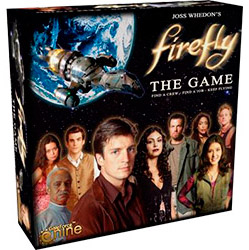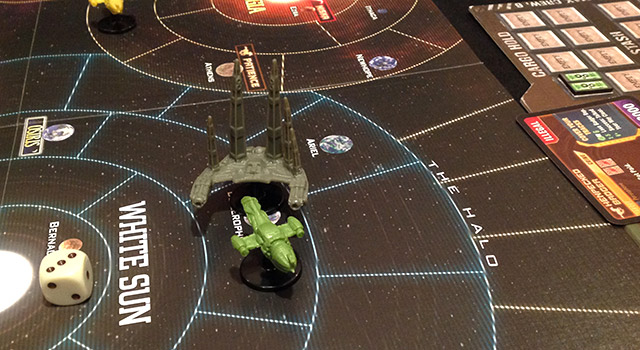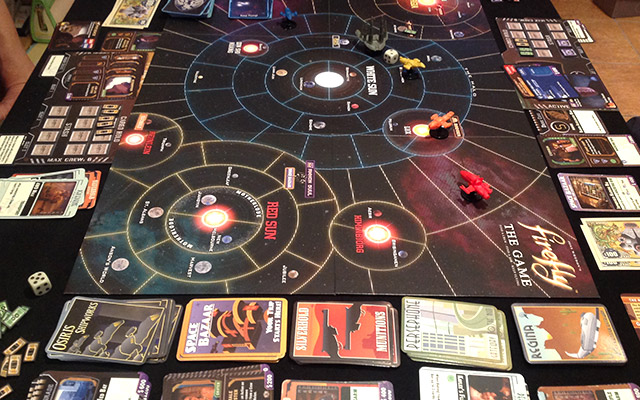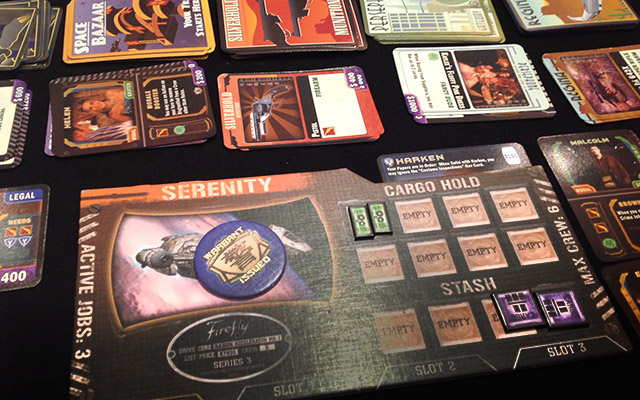
Someone ever tries to kill you, you try to kill ’em right back!
Gales Force Nine finally lets us board gamers explore the ’verse.
 Come and listen to a story about a man named Joss
Come and listen to a story about a man named Joss
A poor screenwriter, networks hardly gave a toss,
Then one day he came up with space and West,
And all but the suits thought it was just the best.
Geeks that is, Browncoats, rabid fans.
Well the next thing you know ol’ Joss is a star,
Avengers is a hit (though S.H.I.E.L.D. is F.U.B.A.R.),
But the fans won’t forget their very favourite name
So Gale Force Nine came along and made a game.
Firefly: The Game, that is. Plastic bits, cardboard.
(Cough) Sorry about that. Well, you know the story: Firefly TV series, best show ever, cancelled by idiot TV network, fan uprising, Serenity film, best loved stuff ever … righto, we’ve got the backstory out of the way—how’s the game?
Well, the good new is that Firefly: The Game does exactly what you want a boardgame based on Firefly to do. The not-so-great but still not-that-bad news is that there’s nothing particularly new in boardgame design here. You get a ship, you fly around the ’verse, you get crew and stuff, you buy and sell stuff, and if you’re a fan (like me) you grab every opporunity to quote a line from the shows. If you’re not a fan, you’ll still enjoy yourself. If you like strategic Euro games, get along now lil’ doggie!
The good news is that the game does exactly what you want a boardgame based on Firefly to do
The rules are are a pretty standard mix of move, buy, pick up and fulfil jobs, and skill tests. Each turn, each player may take up to two actions, choosing from fly, buy, deal, or work. You’ll be flying your little plastic Firefly-class spaceship around a lot, so let’s tackle that first. When you move, you can choose to ‘mosey’, in which case you potter along just one sector on the board; or ‘full burn’, by spending a fuel token and moving sectors up to your drive core’s maximum range. However every time you move into a sector on full burn, you have to draw from either the Alliance space or Border space decks. Most of the time this means you just keep flying, but occasionally you may bump into something inconvenient—especially if another player takes the opportunity to move an Alliance or Reaver ship into your sector.
Once you hit one of the main planets you have the option to either purchase supply cards (crew, gear and ship upgrades) and restock fuel and parts, or to give your crew shore leave. When you buy cards, a slightly unusual mechanic gives you some interesting options (the same mechanic applies when you look for jobs). You can look through the discard deck of the appropriate planet’s deck and choose up to three cards; for each card less than three that you choose, you draw a card blind from the deck. Finally, you can choose to actually buy up to two of these cards and discard the rest. This system initially slows down play, but you’ll soon get the hang of flipping through the discard piles when it’s not your turn and you’re planning your next move.
Instead of buying stuff, you can give your crew shore leave. Sometimes your crew will get, well, disgruntled (usually when you forget to pay them), and paying the bank one hundred credits per crew will cheer them all up again. A crew card with a disgruntled token can not only be nabbed by another player, but if they get two tokens, they’ll leave your ship.

Now you’ve bought yourself some crew and some gear, it’s time to make a livin’! At particular planets (and in the same sector as the Alliance cruiser) you can deal with a contact (fans will recognise these characters from the shows), each of which offers a different balance of risk and reward. Look through the deck in the same way as you did to get crew and gear to choose your jobs—you can keep three in your hand and three active at any one time—and start planning your routes. Jobs range from innocent little pick up and delivery errands to highly illegal (and profitable) capers … of questionable morale value.
You advance (and complete) a job by taking a work action; as long as you’re in the right location and you’ve met the job’s criteria that is. Assign gear cards to your crew and follow the instructions on the card to work the job. When you’re working an illegal job, you better ‘aim to misbehave’: draw the indicated number of cards from the Misbehave deck and try to complete them, either by having the right combination of skills in your crew, or by making a particular skill test. Skill tests are simple: roll a die and add the total number of icons (fight, tech or negotiate) you have amongst the crew and items you have on the job to beat a given number. You may end up botching the job, getting a warrant issued on your ship or—if you’re smart and lucky—getting paid.
Assuming you’re successful, you get a bunch of credits (don’t forget to pay your crew lest they get disgruntled). And lovely intricately-designed paper money credits they are.
In a nutshell, that’s it. There’s very little player interaction (if you’re in the same sector, you can trade; you can steal a disgruntled crew member if you pay their hiring cost; and you can try to harass other players with the Alliance cruiser and the Reaver ship), and players pretty much follow their goals in isolation, but after you’ve got a game or two under your belt the game cruises comfortably along. You can choose to play it straight and narrow, doing safe jobs with low risk and keeping on the good side of the Alliance, or you can go for the big paydays and hope you’ve got the luck and the right stuff to pull them off.

It’s a game for pretending to be a spaceship captain and immersing yourself in the theme
The game would work nicely if they left it there, but there are also several scenarios that add a bit of a story element to proceedings, with various goals the players have to achieve to win. Some of these seem virtually impossible on first glance, though I’m sure experienced players will be able to tackle them with confidence, though the play time estimates do seem a mite over-confident: this can be quite a long game depending on the number of players, and I imagine very few games will clock in at the suggested two hours.
Visually, Firefly: The Game is a slightly confusing beast. Everything works pretty well, there is a lot of character in the design, and the game is chock-full of stills from the TV series and movie; but there’s also a frustrating inconsistency in quality. For example, the backs of the Supply decks are inspired, done in the style of vintage travel posters, and the Set Up and Misbehave cards have a gorgeous retro feel. The paper money is convincingly authentic. But then you come to the lacklustre cargo and passenger tokens, or the weird disgruntled token, which looks like it was whipped out at the last minute in Adobe Illustrator. Inexperience is apparent in the typography: there are too many incompatible fonts jumbled together on the cards. For me, the biggest disappointment is the box cover, which is a pretty amateurish Photoshop collage complete with canned glow filter effects. Of course players who aren’t obsessive graphic designers like me likely won’t notice these visual inconsistencies. I have no grumbles about the production quality however; the cards and pieces are of excellent quality, and the plastic box insert is a very welcome addition.

If you have gaming friends whose idea of a good time is nutting out strategic problem-solving and pushing little wooden cubes around in finely-tuned systems of resource management, shepherd them quickly past this game and towards another. This is not a game for Euro-fans, who are going to wonder what the gorram hell everyone is so excited about, it’s a game for riding the vicissitudes of luck, pretending to be a spaceship captain, reading out fluff text and immersing yourself in the theme of Wild-Space-meets-Wild West. You don’t have to be a fan of the TV series and movie, but it sure ruttin’ helps.
Firefly: The Game knows exactly what kind of game it wants to be and does it well. I do crave more more player interaction and a few unexpected surprises, however. Either GF9 picked up on the zeitgeist or they had it planned all along, but the quick release of two expansions may do the trick. Pirates & Bounty Hunters adds some much-needed player-vs-player action, and Breakin’ Atmo adds, well, a lot more stuff. And this is the kind of game where more stuff equals more fun. I’ve enjoyed Firefly: The Game a lot, so I’ll definitely be grabbing both expansions.
In fact—no power in the ’verse can stop me.
Don’t forget to grab the EOG rules summary and reference sheet before you head out into the black.
Thank you!
Another great review. I’ve had my eye on this for a while, and will hopefully pick it up soon.
Thanks ’Slug!
I must say spot on review – the game has quality parts and caters to fans of the show. The only downside is it take a long time, and has a sizable footprint. I say think of it as a Risk type game you leave up for three hours and take a break from at some point. It takes a while to ramp up building money and crew but once you get going it draws you in.
You’re right, it probably takes a little too long to play. But it’s a pretty relaxing and enjoyable experience, not a brain burner, so a good way to spend a few hours with the right people.
Oh Crom… So many cards…
Yep. Fun huh?! 🙂
@UH: Agents of S.H.I.E.L.D. is now halfway through its 3rd season. Still think it’s F.U.B.A.R.? 😉
Havn’t had a chance to see it yet – has it improved?
Hmmm. That’s a tough question as individual tastes vary so much. But… I guess I’ll just say that in general, even the critics of the show’s first season now say it’s improved. Some say by a lot. Others say it now bears watching. Me, I found the 1st season to be reasonably enjoyable, especially after the Captain America tie-in. Season 2 started off a bit shaky then took off with a bang. Season 3 hasn’t stopped yet to let us catch our breaths.
Can’t edit comment: season 3 “has just stopped to let us catch our breath”.
I’ll watch it eventually and see, but I was very disappointed with what I’ve seen up until now. I thought the scripts were clunky, stories uninteresting, characters boring, acting dull … 🙂
Yeah. I think that early first season they were coasting on the whole Agents of S.H.I.E.L.D. name. They soon learned their mistake.